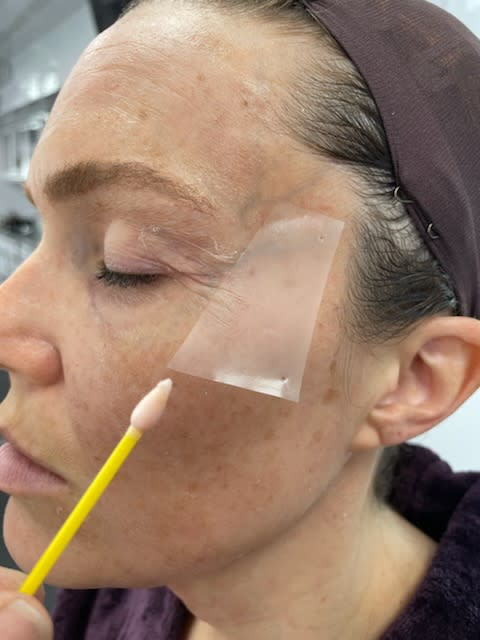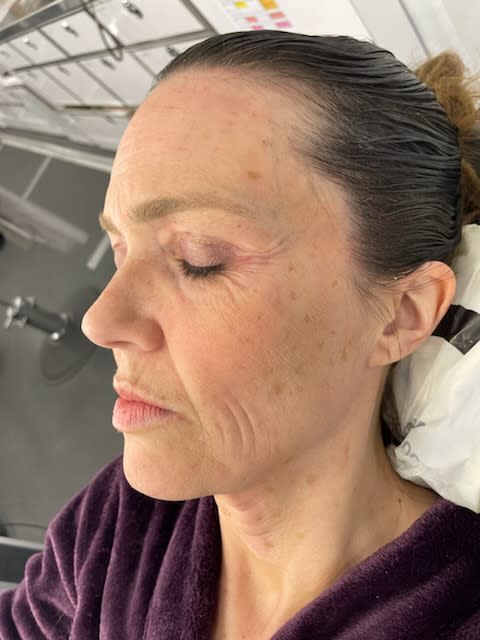‘This Is Us ’ Makeup and Hair Team Detail Mandy Moore’s Hour-Long Wig Process and More
- Oops!Something went wrong.Please try again later.

Makeup department head Zoe Hay and hair department head Michael Reitz accepted a unique creative opportunity when they joined NBC’s “This Is Us” six years ago. They were tasked with aging family matriarch Rebecca Pearson, played by Mandy Moore, from age 16 to 80. “It was an unusual challenge,” Hay says, recalling the early days of the show, which just concluded its final season.
The family drama, which has earned 38 Primetime Emmy nominations including four for hair and makeup, is a multigenerational story that spans more than six decades and centers on the Pearson family at various points in their lives. The Pearsons’ story unfolds in a nonlinear way, and when Hay and Reitz signed on, no one realized what the work would entail — nor how many hours it would take. Between skull caps and wig placement, it often took about 60 minutes just to get Moore’s hair right.
More from Variety
Applying the various makeup looks took about three hours at a time, especially when prosthetics were involved. Adding an additional 60-90 minutes for removing them after a day of filming made for many long days.
NBC
While members of the crew were celebrating a short 12-hour day on set, Moore’s day would last up to 18 hours including time in the makeup chair. “Most of the time I embraced it,” Moore says. “You’ve got to lean in and go, ‘OK, this is what it is.’ And you have to submit and go I am here for the next three hours. Let’s do this.”
Moore, who was 34 when the show premiered in 2016, credits Hay, Reitz and costume designer Hala Bahmet with helping create the beloved character.
“I’ve never been a part of episodic television to this degree before,” Moore says. “I got so used to that schedule of bopping around and recognizing every day is going to bring something new on the show. That’s why it was such a delicious challenge for six years. I never ever sailed through the gates of work going, ‘I could just coast in today on autopilot.’ I was always kept on my toes.”
Moore had a “blast” leaning into Rebecca in different eras, and the makeup and hair were vital components to her unique transformation. To achieve the look for 16-year-old Rebecca, Hay used eye masks, primers and “pretty, yummy foundations to make Moore’s skin look glowing and alive.” To reflect teenage Rebecca’s hair, her wig was lighter and brighter. It was all part of the process that would only get more complicated and creative as they grew the character into middle age and beyond.
Moving into the ’70s, as Rebecca entered her 20s, Hay added more color to her palette saying, “It was the ’70s, it was really fun.”
At the same time, Reitz and his team got to work with Moore’s natural hair, adding extensions when they needed it to be a bit longer. Joni Mitchell was one of their biggest hair inspirations for Rebecca’s transition into young adulthood and early married life.
But when she became a mother in the 1980s, Rebecca’s look changed again. Reitz still focused on her natural hair, but Hay started toning things down.
“We’re using a little bit less foundation or not using concealer any – more,” she says. “And we’re using less color in the makeup. All of these things help make these transitions as she gets older.”
NBC
Signs of Rebecca’s age began to show toward the end of the ’90s after she loses her husband, Jack (Milo Ventimiglia), and has to face a life she never anticipated. For the makeup design, this meant making her skin look a little duller and less vibrant. It also meant introducing an age stippling product that helped create the beginning signs of wrinkles.
“In order to make them look realistic, we’re looking at Mandy’s face and how her skin moves when she expresses, but also looking at photos of women that are at that age,” says Hay. “How do their faces express? How do their smile lines look? How do their wrinkles start to form so that we can start to create those fine lines that start happening with expression?”
Reitz’s task involved designing wigs for points in Rebecca’s life. He worked closely with wig maker Stacey Butterworth on a collection of 10 different styles. As Rebecca gets older, not only do the hairstyles change, but the color and texture need to evolve too. They would start by deciding on a style from one time period and then take it through a progression into the next.
We’d pull all the colors out and bring some elements from the other period into that wig. Say she was brown, we would still put helped create the beginning signs of wrinkles. “In order to make them look realistic, we’re looking at Mandy’s face and how her skin moves when she expresses, but also looking at photos of women that are at that age,” says Hay. “How do their faces express? How do their smile lines look? How do their wrinkles start to form so that we can start to create those fine lines that start happening with expression?” Reitz’s task involved designing wigs for points in Rebecca’s life. He worked closely with wig maker Stacey Butterworth on a collection of 10 different styles. As Rebecca gets older, not only do the hairstyles change, but the color and texture need to evolve too. They would start by deciding on a style from one time period and then take it through a progression into the next. “We’d pull all the colors out and bring some elements from the other period into that wig. Say she was brown, we would still put some of that brown woven into the hair. Not a lot, but just some to carry it through to make it all seamless,” says Reitz.
Over time, they included less of her natural color, giving way to gray.
In the sixth season, Rebecca underwent her most substantial transformation as the final episodes spend more time in the present and future. All of the Pearsons were aging, but none as quickly as Rebecca, declining from both advancing years and the onset of Alzheimer’s disease.
“It becomes a little trickier because you’re having to use a lot more prosthetics on the face. But you have to be very careful to walk the line to have it not be mask-like,” Hays says, noting that she found balance by making sure the pieces were not heavy.
The advanced ages also gave Hay an opportunity for even more close collaboration with the hair and wardrobe departments to determine which areas needed makeup and which could be covered with a particular sweater or well-placed strands of hair.
The team applied prosthetics to Moore’s hands to “mimic more of that arthritic look,” Hay explains. Moore recalls the prosthetics on her hand being paper thin.
“I would brush up against something the wrong way and they would start to roll up a little bit. I’d have to be very, very, very careful,” she says. “Luckily, I spent a lot of time in bed so it’s not like I was doing lots of manual labor. I wasn’t really using my hands that much, but it was something I had to be very mindful of.”
Overall, the process helped Moore as an actor.
“I was just constantly like, ‘OK, what’s next? Who am I?’ And I really think hair, makeup and wardrobe definitely helped solidify all of that,” she says. “It would be different if I were just having to show up in my normal clothes and have to be someone completely different. I think maybe it’s a little bit more challenging. I had the benefit of being able to really lean on transforming into some – one that I am not at all.”
Best of Variety
Sign up for Variety’s Newsletter. For the latest news, follow us on Facebook, Twitter, and Instagram.



